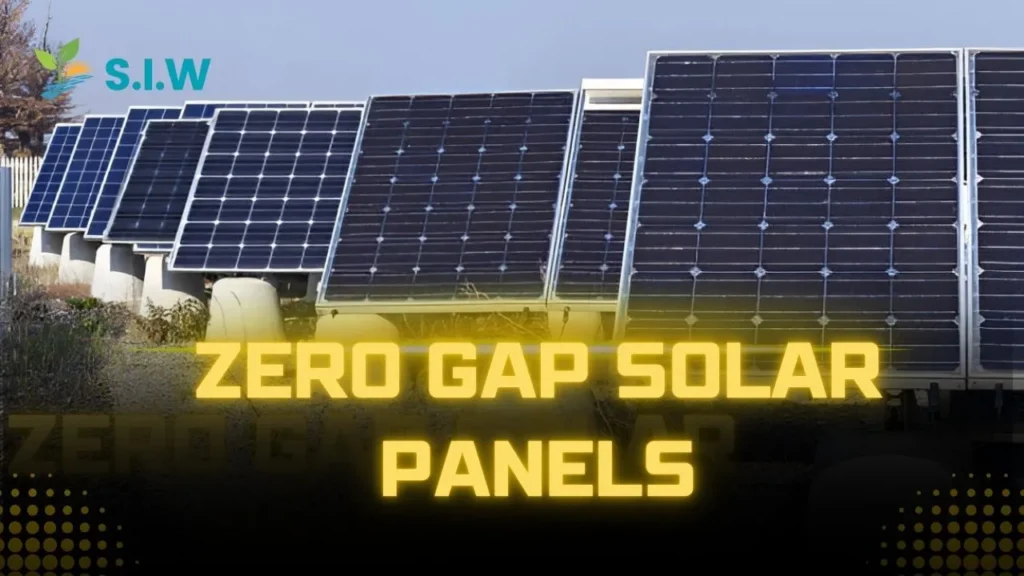Zero gap solar panels have become a ground-breaking invention in the search for renewable and sustainable energy sources. This innovative technique offers considerable reductions in energy loss and better efficiency, potentially revolutionizing the way we use solar electricity. In-depth discussion of zero gap solar panels’ benefits, technological developments, and possible effects on the world energy scene are provided in this extensive piece.
What are Zero Gap Solar Panels?
Zero gap solar panels are an advanced type of photovoltaic system designed to minimize the spaces between individual solar cells. Traditional solar panels have gaps between the cells, which can lead to energy losses and reduced efficiency. By eliminating these gaps, zero gap solar panels maximize the surface area available for sunlight absorption, thereby enhancing overall energy output.
The Technology Behind Zero Gap Solar Panels
1. High-Density Cell Arrangement
The core innovation of zero gap solar panels lies in their high-density cell arrangement. Unlike conventional panels, where cells are spaced apart to prevent overheating and electrical interference, zero gap panels utilize a precise, interlocking design that allows cells to be placed closer together. This arrangement not only increases the number of cells per panel but also reduces the inactive areas that do not contribute to energy generation.
2. Advanced Heat Dissipation Techniques
One of the challenges in developing zero gap solar panels is managing the heat generated by the closely packed cells. Advanced heat dissipation techniques, such as integrated cooling systems and thermally conductive materials, are employed to ensure that the panels operate efficiently without overheating. These innovations help maintain optimal performance and prolong the lifespan of the panels.
3. Enhanced Photovoltaic Materials
An further important element in the success of zero gap solar panels is the utilization of improved photovoltaic materials. Novel varieties of solar cells, like heterojunction and tandem cells, have been created by researchers; these cells function better in a range of lighting scenarios and have higher efficiency rates. Zero gap panels are able to collect more sunlight and transform it into useful energy thanks to these materials.
Advantages of Zero Gap Solar Panels
1. Increased Energy Efficiency
The primary advantage of zero gap solar panels is their increased energy efficiency. By eliminating gaps between cells, these panels can capture more sunlight and convert it into electricity more effectively. This results in higher power output per square meter compared to traditional solar panels.
2. Reduced Installation Footprint
Zero gap solar panels are perfect for both residential and commercial applications since they require less space to install. Because there are fewer panels required to produce the same amount of power due to the higher energy density, installation costs are lowered overall and space is saved.
3. Lower Energy Losses
Traditional Commercial solar panels can suffer from energy losses due to the gaps between cells and the subsequent shading effects. Zero gap solar panels minimize these losses by ensuring that the entire surface area is utilized for energy generation. This leads to more consistent and reliable power production.
4. Aesthetic Appeal
In addition to their functional benefits, zero gap solar panels offer a sleek and modern aesthetic. The seamless design and uniform appearance make them an attractive option for homeowners and businesses looking to integrate renewable energy solutions without compromising on visual appeal.
Applications of Zero Gap Solar Panels
1. Residential Use
Zero gap solar panels are particularly well-suited for residential use. Homeowners can benefit from the increased efficiency and reduced installation footprint of solar power systems for home, allowing them to generate more power even in limited spaces. The panels can be installed on rooftops, facades, or integrated into building materials for a seamless look.
2. Commercial and Industrial Use
For commercial and industrial applications, zero gap solar panels offer significant advantages. Businesses can reduce their energy costs and carbon footprint by installing these high-efficiency panels on large rooftops or open spaces. The ability to generate more power per square meter also makes them ideal for large-scale solar farms and renewable energy projects.
3. Urban and Public Infrastructure
Zero gap solar panels can play a crucial role in urban and public infrastructure projects. They can be integrated into the design of public buildings, transportation hubs, and other facilities to provide a sustainable and reliable source of energy. The panels’ aesthetic appeal also makes them suitable for use in urban environments where visual integration is important.
Challenges and Future Prospects
1. Production Costs
One of the main challenges facing the widespread adoption of zero gap solar panels is the production cost. The advanced materials and manufacturing techniques required for these panels can be more expensive than those used for traditional solar panels. However, as technology advances and economies of scale are achieved, it is expected that production costs will decrease, making zero gap panels more accessible to a broader market.
2. Technological Advancements
The future of zero gap solar panels is closely tied to ongoing technological advancements. Researchers are continually exploring new materials, cell designs, and manufacturing processes to improve efficiency and reduce costs. Innovations such as perovskite solar cells and multi-junction cells hold promise for further enhancing the performance of zero gap panels.
3. Market Adoption
Market adoption of zero gap solar panels will depend on a variety of factors, including government policies, incentives, and public awareness. As more people and businesses recognize the benefits of these high-efficiency panels, demand is likely to increase, driving further investment and development in the sector.
Conclusion
With their higher efficiency, lower energy losses, and more aesthetically beautiful design, zero gap solar panels mark a substantial advancement in solar technology. These panels could eventually become a commonplace answer for both residential and commercial energy needs as production costs fall down and technology advances. Adopting zero gap solar panels is an essential first step toward a future with more renewable and sustainable energy sources.








